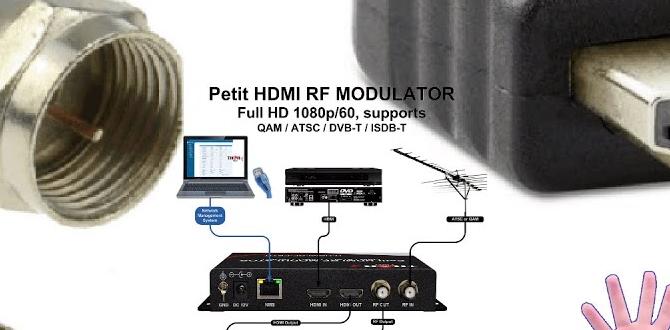A ratcheting adapter for your drill is a clever tool that lets you tighten or loosen fasteners without constantly repositioning your drill. It’s like a built-in gear system that makes jobs faster and easier, especially in tight spots. Think of it as giving your drill a superpower for tricky tasks!
Ever found yourself wrestling with a bolt or screw in a cramped space, your drill awkwardly angled, and your wrist aching? It’s a common frustration for DIYers and even seasoned pros. Trying to get enough torque to tighten or loosen something when you can’t get a full turn of your wrist is a real pain. This usually means a lot of back-and-forth with your drill, taking forever and making your arm tired. But what if there was a simpler way? There is! It’s a genius little tool called a ratcheting adapter for your drill. This clever attachment can turn a frustrating job into a smooth, efficient task. Stick around, and I’ll show you exactly how this simple tool can be a game-changer for your projects.
What is a Ratcheting Adapter for a Drill?
Imagine your drill could “ratchet” like a socket wrench. That’s essentially what a ratcheting adapter for a drill does. It’s a special attachment that connects between your drill’s chuck and your drill bit or socket. The magic lies in its internal mechanism, which allows the adapter to move freely in one direction (like when your drill is spinning to tighten or loosen) but engage and transfer power in the other. This means you only need a small movement of your wrist or the drill itself to keep turning the fastener. Instead of lifting your drill off the fastener for each turn, the adapter lets you keep the drill steady and just pivot your wrist back and forth.
Think of a regular socket wrench. When you’re working on a bolt, you turn the handle, then you lift it up, reposition it, and turn again. A ratcheting socket wrench does the same thing but with a little lever. When you switch the lever one way, turning the handle forward tightens; turning it backward just lets the handle spin freely. You don’t have to lift and reposition. A ratcheting adapter for your drill mimics this convenience, but with the power and speed of your cordless drill. It’s a small tool with a big impact on how efficiently you can work.
How Does the Ratcheting Mechanism Work?
At its core, a ratcheting adapter uses a series of teeth and pawls, similar to what you’d find in a standard ratcheting wrench. When you apply force in the “work” direction (tightening or loosening, depending on the adapter’s setting), the pawls engage the teeth, and the adapter turns the attached bit. When you reverse the direction of your drill, the pawls simply slide over the teeth, allowing the adapter to move freely without turning the bit. This means your drill bit stays engaged with the fastener, and you only need to pivot your wrist or adjust your grip slightly to keep the rotation going.
The direction of the ratcheting action is usually controlled by a small switch or collar on the adapter itself. You set it to either clockwise (for tightening) or counter-clockwise (for loosening) rotation. When you’re drilling or driving into a material, you typically want the adapter set to the tightening direction. When you’re removing a screw or bolt, you’ll switch it to the loosening direction. This simple switch is what makes the tool so versatile for both driving in and taking out fasteners.
Why is a Ratcheting Adapter a Genius Feature?
The “genius” lies in its simplicity and the significant problem it solves. Many of us have encountered situations where standard drilling or driving is a real challenge. This is especially true when working in shallow or confined spaces where a full rotation of the drill is impossible. The ratcheting adapter removes this limitation, allowing you to effectively work in areas that would otherwise require specialized, expensive tools or a lot of manual effort.
Here are some of the key reasons why this feature is so brilliant:
- Work in Tight Spaces: This is the most significant benefit. If you can only manage a quarter or half turn with your drill, the ratcheting adapter lets you keep going without removing the drill bit from the screw head or bolt.
- Reduced Fatigue: Constantly repositioning your drill is tiring. The ratcheting action minimizes the movement required, saving your wrists and arms, especially during long projects.
- Faster Work: By eliminating the pauses and repositioning needed for each turn, you can complete tasks much more quickly.
- Improved Accuracy and Control: Keeping the drill bit engaged with the fastener provides better control, leading to more precise driving and a reduced chance of stripping screw heads or damaging materials.
- Versatility: These adapters can be used with a wide variety of drill bits, including screwdriver bits, nut drivers, and even small sockets, making them useful for many different tasks.
- Cost-Effective: Compared to specialized tools designed for tight spaces (like offset screwdrivers or knuckle adapters), a ratcheting adapter is a much more affordable solution.
Think about working on automotive components, inside cabinets, or even assembling furniture – many common tasks involve screws or bolts in places where straight-on access is difficult. The ratcheting adapter turns these awkward jobs into manageable ones.
Types of Ratcheting Adapters for Drills
While the core function remains the same, ratcheting adapters come in a few variations, primarily differing in their connection type and the drive size they accommodate. Understanding these differences will help you choose the right one for your needs.
The most common types are:
- 1/4-Inch Hex Shank Adapters: This is the most prevalent type, as 1/4-inch hex shanks are standard for most screwdriver bits used with drills. These adapters connect directly to the drill’s chuck and accept standard 1/4-inch hex bits.
- Socket Adapters: These adapters have a 1/4-inch hex shank to go into your drill and then a square drive on the other end (e.g., 1/4-inch, 3/8-inch, or 1/2-inch) to accept standard sockets. This is incredibly useful for driving nuts and bolts.
- Bit Holders with Ratchet Function: Some products combine a magnetic bit holder with a ratcheting mechanism. These are often shorter and designed specifically to hold 1/4-inch hex screwdriver bits.
The choice between them often depends on the type of fasteners you’ll be working with. If you’re mostly driving screws, a hex shank adapter is perfect. If you’re dealing with nuts and bolts or need to use your socket set, a socket adapter is the way to go.
Key Features to Look For
When shopping for a ratcheting adapter, consider these important features to ensure you get a reliable and effective tool:
- Durability of Materials: Look for adapters made from hardened steel for longevity, especially if you plan to use them for demanding tasks.
- Ratcheting Mechanism Quality: A smooth, precise ratcheting action is crucial. Cheaper mechanisms can feel sticky or fail to engage properly.
- Directional Control: Ensure the switch for changing the ratcheting direction is easy to operate, even with gloves on, and stays securely in place.
- Compact Size: For working in very tight spaces, a shorter profile adapter can be a significant advantage.
- Magnetic Tip (for bit holders): Some adapters have a magnetic tip to help hold screws or bits securely, preventing them from dropping.
- Compatibility: Make sure the shank size matches your drill’s chuck (usually 1/4-inch hex) and the drive size matches your bits or sockets.
Reading reviews from other users can also provide valuable insights into the performance and durability of different models.
How to Use a Ratcheting Adapter for Your Drill
Using a ratcheting adapter is straightforward, especially if you have basic experience with a drill. The steps are simple and designed to be intuitive. We’ll cover both setting it up and the actual operation.
Step-by-Step Guide to Using Your Ratcheting Adapter
Let’s break down how to get this handy tool working for you. Remember to always wear safety glasses!
Step 1: Select the Right Adapter and Bit/Socket
First, decide what you need to fasten or loosen. If it’s screws, choose your screwdriver bit (Phillips, flathead, Torx, etc.). If it’s nuts or bolts, select the correct size socket. Ensure the adapter you’ve chosen can accommodate this bit or socket (e.g., a 1/4-inch hex adapter for screwdriver bits, or a 3/8-inch drive socket adapter for sockets).
Step 2: Attach the Adapter to Your Drill
If you’re using a hex shank adapter, insert the 1/4-inch hex shank end into your drill’s chuck. Tighten the chuck securely, just as you would with a regular drill bit or screwdriver bit. If you are using a socket adapter, the process is the same, as the hex shank connects to the drill.
Step 3: Attach the Bit or Socket to the Adapter
Now, attach your chosen screwdriver bit or socket to the other end of the ratcheting adapter. Most adapters have a detent ball or a quick-release mechanism to hold the bit or socket securely.
Step 4: Set the Ratcheting Direction
Locate the directional switch on the ratcheting adapter. Set it according to your task: ‘CW’ (Clockwise) for tightening, or ‘CCW’ (Counter-Clockwise) for loosening. This is the crucial step that enables the ratcheting action.
Step 5: Position Your Drill and Fastener
Carefully place your drill bit or socket onto the screw head or nut. Ensure it’s seated as squarely as possible to prevent slipping or stripping. For difficult-to-reach areas, position your drill so that you have enough room to move your wrist or the front of the drill back and forth.
Step 6: Begin Driving or Loosening
Gently squeeze the trigger on your drill. Start with a low speed to ensure the bit is properly engaged. As the adapter turns the fastener:
- To Tighten: When you can’t turn the drill any further in the tightening direction, simply move the front of the drill (or pivot your wrist) back slightly. The adapter ratchets freely in this reverse direction. Then, move forward again to continue tightening.
- To Loosen: When you can’t turn the drill any further in the loosening direction, move the front of the drill (or pivot your wrist) back slightly. The adapter ratchets freely in this reverse direction. Then, move forward again to continue loosening.
Continue this back-and-forth motion. The drill motor does the work, and the ratcheting adapter allows for constant contact and a steady turning motion, even with very limited space for your drill body.
Step 7: Release and Review
Once the fastener is tightened or loosened, release the drill trigger. Remove the drill from the fastener. Check that the fastener is secure or removed as intended. If you need to switch to a different fastener or set of tasks, remember to reset the directional switch if necessary.
Tips for Optimal Use
To get the most out of your ratcheting adapter, keep these tips in mind:
- Start Slow: Always begin with a low drill speed. This helps you seat the bit properly and avoids cam-outs (slipping out of the screw head).
- Maintain Engagement: Try to keep the drill bit or socket firmly seated in the fastener throughout the process.
- Low Torque Settings: For driving screws, use your drill’s clutch settings to avoid overtightening and stripping. The ratcheting adapter itself doesn’t control torque.
- Cleanliness: Keep your adapter and bits clean to ensure smooth operation.
- Listen to the Tool: If the ratcheting mechanism sounds rough or grinds, stop and check for debris or damage.
When to Use a Ratcheting Adapter (Common Scenarios)
The versatility of a ratcheting adapter means it can be incredibly useful in a wide array of situations. Its primary advantage shines when traditional methods become cumbersome or impossible. Here are some common scenarios where this tool proves to be indispensable:
Automotive Repairs
Working on cars often involves cramped engine bays and tight wheel wells. The ratcheting adapter is a lifesaver for tasks like:
- Tightening or loosening bolts and nuts on engine components, like fuel rails or intake manifolds.
- Accessing hard-to-reach screws on interior panels or dashboard components.
- Working with brake calipers or suspension components where space is limited.
For automotive enthusiasts and mechanics, having a set of socket adapters for their drill is almost a necessity. Resources like Sema Sanctuary’s basic car maintenance guide often highlight the benefits of having the right tools for tight spots.
Home Improvement and DIY Projects
From building furniture to installing fixtures, DIYers will find this adapter incredibly handy:
- Assembling flat-pack furniture where screws might be in tight corners.
- Installing kitchen cabinets or bathroom vanities where space behind or around them is at a premium.
- Working on intricate woodworking projects that require precise fastening in awkward angles.
- Mounting shelves, curtain rods, or light fixtures in tight wall cavities.
Electronics and Computer Repair
While often requiring smaller bits, some electronic devices can still present access challenges:
- Disassembling or reassembling computer towers or gaming consoles where internal space is tight.
- Working on appliances with hard-to-reach screws for panels or components.
- Repairing or maintaining drones or other small electronic devices.
General Maintenance and Assembly
Any task involving nuts, bolts, or screws in a confined area can benefit:
- Tightening leg bolts on chairs or tables.
- Assembling exercise equipment.
- Working on machinery where access panels are small.
- Any situation where your drill body obstructs a full turn.
The beauty of the ratcheting adapter is that it transforms a potentially frustrating, time-consuming task into a quick and simple one. It’s the kind of tool that, once you use it, you’ll wonder how you ever managed without it.
Advantages and Disadvantages of Ratcheting Adapters
Like any tool, ratcheting adapters offer great benefits but also have a few limitations. Understanding both sides helps you decide if it’s the right addition to your toolbox.
Advantages
Disadvantages
Here’s a quick comparison:
| Advantages | Disadvantages |
|---|---|
| Works in extremely tight spaces where full drill rotation is impossible. | Can add a little length to your drill setup, which might be an issue in extremely confined spaces. |
| Reduces user fatigue by minimizing repetitive wrist and arm movements. | The ratcheting mechanism itself can add weight, although usually very minimal. |
| Increases speed and efficiency of fastening/loosening tasks. | Requires a separate tool to carry and manage. |
| Improves control and accuracy, reducing the risk of stripping fasteners. | Not suitable for very high-torque applications that could damage the internal mechanism if pushed too hard. |
| Cost-effective solution compared to specialized corner drills or offset tools. | The directional switch could potentially fail over time if not maintained or if used improperly. |
| Versatile, usable with various bits and sockets for different tasks. | May not offer the same level of finesse as manual hand tools for very delicate operations. |
Even with the disadvantages, the advantages of a ratcheting adapter for a drill generally far outweigh them for most common DIY and light-to-medium professional tasks. The convenience and problem-solving capability it offers are substantial.
Safety Considerations When Using a Ratcheting Adapter
Safety is paramount with any power tool accessory. While ratcheting adapters simplify tasks, it’s crucial to use them correctly to avoid accidents. Always remember these points:
- Wear Safety Glasses: This is non-negotiable. Flying debris, whether it’s metal shavings, wood splinters, or a slipped bit, can cause serious eye injury.
- Ensure Secure Fitment: Always make sure the adapter is securely locked into your drill chuck and that your bit or socket is firmly seated in the adapter. A loose fitting can lead to the tool slipping off, damaging the fastener, or causing injury.
- Know Your Drill’s Limits: Do



